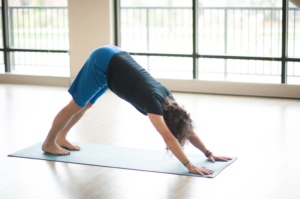 In 1989, I went to Pune, India, to study with Geeta and B.K.S. Iyengar. A group of 30-some dedicated practitioners from around the U.S. joined senior teacher Mary Dunn for a three-week intensive.
In 1989, I went to Pune, India, to study with Geeta and B.K.S. Iyengar. A group of 30-some dedicated practitioners from around the U.S. joined senior teacher Mary Dunn for a three-week intensive.
I gravitated toward a group of teachers who all stayed at the same $10 per night hotel—which I’m sure is not nearly that good of a deal these days. In the evenings, we’d gather on one of our balconies and discuss our day of classes.
A theme that kept arising in our discussions was disappointment in the absence of “advanced” poses in our asana classes. Most wanted to learn finer points of fancy poses, eschewing the basic standing poses we were practicing.
On the other hand, I felt that if I had an understanding of Tadasana (Mountain Pose) by the end of our trip, I’d be happy. In Tadasana are the seeds of understanding all the other asanas.
Practicing Your Scales
I’ve played music my entire life. While I didn’t much care for practicing my scales as a child, I’ve come to appreciate that scales and arpeggios are building blocks. Becoming facile in scales and arpeggios in every key gives you the muscle memory you need to play pretty much anything with ease.
Years ago, I attended a workshop with banjoist Béla Fleck. He talked about his lifelong desire to “take off” on his instrument, to tread territory no one had previously explored. If you know his work, you know he has succeeded in this, and then some! But he also spoke about a time when he realized he needed to go back and relearn the basics. He decided to learn everything Earl Scruggs ever recorded on the five-string banjo. In learning the basics, he found that his ability to travel uncharted territory only grew.
I read a similar interview with Jerry Garcia, where he spoke about going back and learning how to read music after being an ear player. Like Fleck, he found that his ability to soar outside the lines was only enhanced by learning the basics.
We can do the same in yoga. Many of us are so anxious to get to what we believe to be the pinnacle of practice—those fancy poses—that we fail to lay the groundwork. Grounding your yoga practice in the basic tools of movement facilitates your inner explorations.
- Simplify your practice: At least some of the time, explore simple poses such as Tadasana, Adho Mukha Svanasana (Downward-Facing Dog), Sukhasana (Easy Pose), Setu Bandhasana (Bridge Pose), Talasana (Palm Tree Pose) and Janu Sirsasana (Head-of-the-Knee Pose). There are many others, of course, including all the wide-legged standing poses. These are just a few suggestions. In these basic poses you can explore the finer points of practice than in poses that require complicated combinations of movements.
- Practice patience: Practice about 5 to 10 percent inside your edge. This allows you to feel more subtle sensations and make finer adjustments. When you are constantly pushing up against your edge, sensations are so intense that you can’t feel anything subtle. If you want to refine your practice with intelligence, you need to be in touch with subtlety.
- Take your time: Spend a minute or so in each pose, letting your breath lead you into your asana, rather than listening to your ego’s call to push further on.
- Give your breath primacy: If you can’t breathe easily in a pose, you are pushing too hard. Find where the breath is restricted—is it in your lower belly, upper chest or midsection? Then back off a bit so that the breath is free. Breathing is always more important than performing.
- Set your foundation: In every pose, something will be in contact with the ground—unless, of course, you’re levitating, but that’s for another post. Whether you’re standing, sitting, kneeling or lying down, start with a solid foundation. Feel how your base is contacting the ground. Is one side grounding while the other side is lifting? Are you collapsing into the ground, or are you propping yourself away from it? Experiment with “active yield.” There’s more info about it in this post.
In the years since that trip to Pune, I’ve studied with lots of Iyengar teachers, and with a few who have an Iyengar foundation, but have struck out on their own paths. Donna Farhi is one of the latter, and her emphasis on grounding your yoga practice in the basics—read her “Seven Moving Principles” in her book, Yoga Mind, Body, Spirit)—brought me back to the roots of movement. Practicing my yogic scales, through Donna’s guidance, has helped me practice with greater ease. Grounding in the basics, every day, has set my practice free.
